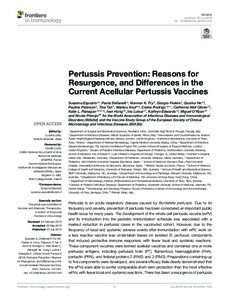Pertussis Prevention: Reasons for Resurgence, and Differences in the Current Acellular Pertussis Vaccines
Esposito S; Stefanelli P; Fry NK; Fedele G; He QS; Paterson P; Tan TN; Knuf M; Rodrigo C; Olivier CW; Flanagan KL; Hung I; Lutsar I; Edwards K; O'Ryan M; Principi N
Pertussis Prevention: Reasons for Resurgence, and Differences in the Current Acellular Pertussis Vaccines
Esposito S
Stefanelli P
Fry NK
Fedele G
He QS
Paterson P
Tan TN
Knuf M
Rodrigo C
Olivier CW
Flanagan KL
Hung I
Lutsar I
Edwards K
O'Ryan M
Principi N
FRONTIERS MEDIA SA
Julkaisun pysyvä osoite on:
https://urn.fi/URN:NBN:fi-fe2021042823071
https://urn.fi/URN:NBN:fi-fe2021042823071
Tiivistelmä
Pertussis is an acute respiratory disease caused by Bordetella pertussis. Due to its frequency and severity, prevention of pertussis has been considered an important public health issue for many years. The development of the whole-cell pertussis vaccine (wPV) and its introduction into the pediatric immunization schedule was associated with a marked reduction in pertussis cases in the vaccinated cohort. However, due to the frequency of local and systemic adverse events after immunization with wPV, work on a less reactive vaccine was undertaken based on isolated B. pertussis components that induced protective immune responses with fewer local and systemic reactions. These component vaccines were termed acellular vaccines and contained one or more pertussis antigens, including pertussis toxin (PT), filamentous haemagglutinin (FHA), pertactin (PRN), and fimbrial proteins 2 (FIM2) and 3 (FIM3). Preparations containing up to five components were developed, and several efficacy trials clearly demonstrated that the aPVs were able to confer comparable short-term protection than the most effective wPVs with fewer local and systemic reactions. There has been a resurgence of pertussis observed in recent years. This paper reports the results of a Consensus Conference organized by the World Association for Infectious Disease and Immunological Disorders (WAidid) on June 22, 2018, in Perugia, Italy, with the goal of evaluating the most important reasons for the pertussis resurgence and the role of different aPVs in this resurgence.
Kokoelmat
- Rinnakkaistallenteet [27094]
